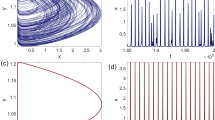Abstract
We consider deterministic descriptions of reaction networks in which different reactions occur on at least two distinct time scales. We show that when a certain Jacobian is nonsingular there is a coordinate system in which the evolution equations for slow and fast variables are separated, and we obtain the appropriate initial conditions for the transformed system. We also discuss topological properties which guarantee that the nonsingularity condition is satisfied, and show that in the new coordinate frame the evolution of the slow variables on the slow time scale is independent of the fast variables to lowest order in a small parameter. Several examples that illustrate the numerical accuracy of the reduction are presented, and an extension of the reduction method to three or more time scale networks is discussed.
Similar content being viewed by others
References
Aris R (1965) Prolegomena to the rational analysis of chemical reactions. Arch Ration Mech Anal 19(2): 81–99
Acrivos A, Bowen J, Oppenheim A (1963) Singular perturbation refinement to quasi-steady state approximation in chemical kinetics. Chem Eng Sci 18: 177–188
Chen WK (1971) Applied graph theory. North-Holland series in applied mathematics and mechanics, vol 13. North-Holland, Amsterdam
Fraser SJ (1988) The steady state and equilibrium approximations: a geometrical picture. J Chem Phys 88: 4732
Gadgil C, Lee CH, Othmer HG (2005) A stochastic analysis of first-order reaction networks. Bull Math Biol 67: 901–946
Gibbons A (1985) Algorithmic graph theory. Cambridge University Press, Cambridge
Gorban AN, Karlin IV (2003) Method of invariant manifold for chemical kinetics. Chem Eng Sci 58(21): 4751–4768
Goussis DA, Valorani M (2006) An efficient iterative algorithm for the approximation of the fast and slow dynamics of stiff systems. J Comput Phys 214(1): 316–346
Haseltine EL, Rawlings JB (2002) Approximate simulation of coupled fast and slow reactions for stochastic chemical kinetics. J Chem Phys 117(15): 6959
Heineken F, Tsuchiya H, Aris R (1967) On the mathematical status of the pseudo-steady state hypothesis of biochemical kinetics. Math Biosci 1: 95–113
Horn F (1972) Necessary and sufficient conditions for complex balancing in chemical kinetics. Arch Ration Mech Anal 49(3): 172–186
Horn F, Jackson R (1972) General mass action kinetics. Arch Ration Mech Anal 48: 81
Kijma H, Kijima S (1982) Steady/equilibrium approximation in relaxation and fluctuation. Biophys Chem 16: 181–192
King EL, Altman C (1956) A schematic method of deriving the rate laws for enzyme-catalyzed reactions. J Phys Chem 60(10): 1375–1378
Kistiakowsky GB, Shaw WHR (1953) On the mechanism of the inhibition of Urease. J Am Chem Soc 75(4): 866–871
Kumar A, Daoutidis P (1999) Control of nonlinear differential algebraic equation systems. Chapman and Hall/CRC, London
Lam SH (1993) Using CSP to understand complex chemical kinetics. Combust Sci Technol 89(5): 375–404
Lam SH, Goussis DA (1994) The CSP method for simplifying kinetics. Int J Chem Kinet 26(4): 461–486
Lin CC, Segel LA (1988) Mathematics applied to deterministic problems in the natural sciences. SIAM
Maas U, Pope SB (1992) Simplifying chemical kinetics: intrinsic low-dimensional manifolds in composition space. Combust Flame 88(3–4): 239–264
Othmer HG (1976) Nonuniqueness of equilibria in closed reacting systems. Chem Eng Sci 31: 993–1003
Othmer HG (1979) A graph-theoretic analysis of chemical reaction networks. Lecture Notes, Rutgers University—available at http://www.math.umn.edu/~othmer/graphrt.pdf
Othmer HG (1981) The interaction of structure and dynamics in chemical reaction networks. In: Ebert KH, Deuflhard P, Jager W (eds) Modelling of chemical reaction systems. Springer, New York, pp 1–19
Othmer HG, Aldridge JA (1978) The effects of cell density and metabolite flux on cellular dynamics. J Math Biol 5: 169–200
Park DJ (1974) The hierarchical structure of metabolic networks and the construction of efficient metabolic simulators. J Theor Biol 46(1): 31–74
Prigogine I, Lefever R (1968) Symmetry breaking instabilities in dissipative structures. J Chem Phys 48: 1695–1700
Srivastava JSR, You L, Yin J (2002) Stochastic versus deterministic modeling of intracellular viral kinetics. J Theor Biol 218: 309–321
Roussel MR, Fraser SJ (1990) Geometry of the steady-state approximation: Perturbation and accelerated convergence methods. J Chem Phys 93: 1072
Roussel MR, Fraser SJ (1991) On the geometry of transient relaxation. J Chem Phys 94: 7106
Roussel MR, Fraser SJ (2001) Invariant manifold methods for metabolic model reduction. Chaos Interdiscip J Nonlinear Sci 11: 196
Segel LA, Slemrod M (1982) The quasi-steady-state assumption: a case study in perturbation. Biophys Chem 16: 181–192
Snow RH (1966) A chemical kinetics computer program for homogeneous and free-radical systems of reactions. J Phys Chem 70(9): 2780–2786
Stiefenhofer M (1998) Quasi-steady-state approximation for chemical reaction networks. J Math Biol 36: 593–609
Tikhonov AN (1952) Systems of differential equations containing small parameters in the derivatives. Matematicheskii Sbornik 73(3): 575–586
Valorani M, Creta F, Goussis DA, Lee JC, Najm HN (2006) An automatic procedure for the simplification of chemical kinetic mechanisms based on CSP. Combust Flame 146(1–2): 29–51
Kaper ZA, Kaper TJ (2004) Fast and slow dynamics for the computational singular perturbation method. Multiscale Model Simul 2(4): 613–638
Zagaris A, Kaper HG, Kaper TJ (2004) Analysis of the computational singular perturbation reduction method for chemical kinetics. J Nonlinear Sci 14(1): 59–91
Author information
Authors and Affiliations
Corresponding author
Rights and permissions
About this article
Cite this article
Lee, C.H., Othmer, H.G. A multi-time-scale analysis of chemical reaction networks: I. Deterministic systems. J. Math. Biol. 60, 387–450 (2010). https://doi.org/10.1007/s00285-009-0269-4
Received:
Revised:
Published:
Issue Date:
DOI: https://doi.org/10.1007/s00285-009-0269-4




